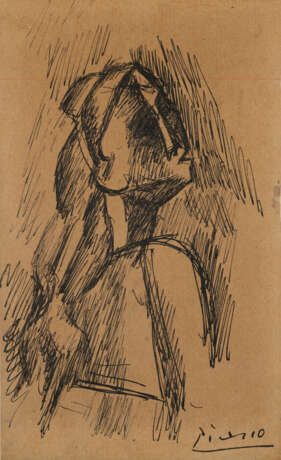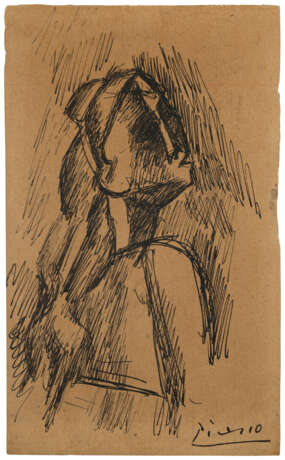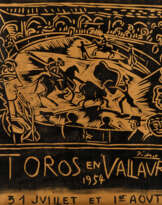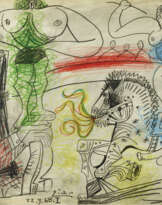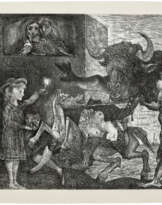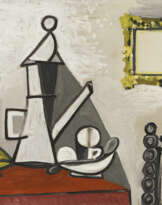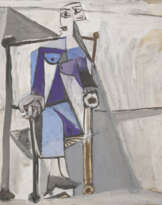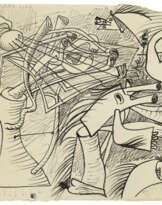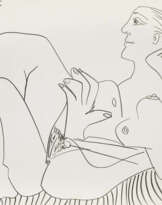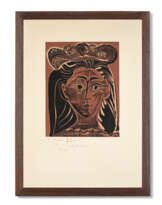ID 929405
Lot 21 | Pablo Picasso (1881-1973)
Valeur estimée
€ 120 000 – 180 000
Tête de femme
signé 'Picasso' (en bas à droite)
plume et encre de Chine sur papier
16.9 x 10.3 cm.
Exécuté en 1908
signed 'Picasso' (lower right)
pen and India ink on paper
6 5/8 x 4 1/8 in.
Executed in 1908
Provenance
Fuji Television Gallery, Tokyo.
Vente, Sotheby's, Londres, 1er avril 1987, lot 345.
Acquis au cours de cette vente par la famille du propriétaire actuel.
Literature
C. Zervos, Pablo Picasso, Supplément aux années 1907-1909, Paris, 1973, vol. 26, no. 383 (illustré, pl. 132).
Special notice
Artist's Resale Right ("droit de Suite").
If the Artist's Resale Right Regulations 2006 apply to this lot, the buyer also agrees to pay us an amount equal to the resale royalty provided for in those Regulations, and we undertake to the buyer to pay such amount to the artist's collection agent.
Post lot text
« La fragmentation picassiennne, les arêtes, les lignes et les plans qu’il nous propose sont des esquilles, des éclats d’un univers qui vient d’être dynamité. »
J. Palau i Fabre, Picasso Cubisme, 1907-1917, Barcelone, 1998, p. 56.
« La précision des plans avec le moindre effort de la ligne, la tendance à l’angle régulier, aux courbes plus proches de l’ellipse que du cercle, des indications par points, par traits et enfin la distribution de la lumière par rapport à l’inclinaison des plans et non selon leur convexité ou leur concavité, voici le dessin moderne de l’âme moderne. »
E. Fry, Cubism, New York, 1978, p. 45.
Aux premières heures du cubisme, Picasso bannit quasiment tous les éléments narratifs et symboliques qui avaient non seulement habité ses œuvres des périodes bleue et rose mais aussi la phase initiale des Demoiselles d'Avignon. Portraits, figures, paysages, natures mortes... Il se limite dès lors à ausculter ces motifs dans ce qu'ils ont de plus élémentaire. En découle une approche nouvelle de la peinture, née de l'observation attentive des choses : Picasso se penche sur la nature même de ses sujets, sur leur structure faite de composantes visibles et d'éléments plus subtils, et traduit ses découvertes dans un langage plastique inédit.
Il se plonge alors pleinement dans les leçons tirées de celui qu'il considère comme son « seul et unique maître », Paul Cézanne. « Cézanne !, affirmera-t-il par la suite. Il était comme notre père à tous. C'est lui qui nous protégeait » (in J. Richardson, A Life of Picasso, 1907-1917, New York, 1996, Vol. II, p. 52). Dans les années 1908-1909, Picasso se défait progressivement du style incisif des Demoiselles d'Avignon qui avait vu naître une cohorte de visages féminins aux traits bruts, anguleux, pareils à des masques primitifs. Loin de toute volonté réaliste, les yeux, le nez, la bouche, les oreilles du présent portrait sont rendus de manière purement plastique. Identifiables au premier coup d'œil, ils s'affichent comme autant d'indices qui, ensemble, donnent corps au personnage. « Les dessins de Picasso détaillent les différentes facettes d'une bouche, d'un nez, réduisant leurs complexités anatomiques à une agglomération de formes limpides et symétriques, écrit Pepe Karmel. Picasso conçoit lui-même cette rigueur géométrique comme l'expression d'une sorte d'archétype platonicien » (Picasso and the Invention of Cubism, New Haven, 2003, p. 64).
C'est en se nourrissant d'études comme celle-ci que Picasso tend alors de plus en plus à intégrer la forme sculpturale dans sa peinture, en mettant l'accent sur les saillies et les volumes de ses sujets. En adoptant des formes fragmentées, l'artiste obtient dans ses toiles et dessins des effets qu'il finit par transposer à des œuvres en trois dimensions, où il fait interagir les vides et les pleins, les creux et les reliefs. En ce sens, il semble tout naturel qu'un bronze de Picasso, Tête de femme (1906-07), vienne marquer le point culminant de ces débuts cubistes, très sculpturaux.
"The Picassian fragmentation, the edges, the lines and the plans that he offers us are splinters, shards of a universe that has just been dynamited."
J. Palau i Fabre, Picasso Cubisme, 1907-1917, Barcelona, 1998, p. 56.
"The precision of the plans with the least effort of the line, the tendency to the regular angle, to the curves closer to the ellipse than to the circle, indications by points, by lines and finally the distribution of the light in relation to the inclination of the plans and not according to their convexity or their concavity, here is the modern drawing of the modern soul."
E. Fry, Cubism, New York, 1978, p. 45.
Having virtually eliminated the narrative and symbolic impetus in his art, which had been inseparable from his work during the Blue and Rose periods and even in the early phase of Les Demoiselles d'Avignon, Pablo Picasso limited his subjects to those he could analyze in their most fundamental aspect as portrait, the figure, still life or landscape. He thusly achieved a new focus and intensity in his picture-making, which came from looking at things, pondering both the outward and latent elements in their structural constitution, and translating these findings into new pictorial means. Picasso had begun to work deeply within the legacy of Cézanne, who "was my only master," he later declared. "It was the same for all of us–he was like our father. It was he who protected us" (quoted in J. Richardson, A Life of Picasso, 1907-1917, New York, 1996, Vol. II, p. 52).
In the years of 1908 and 1909, Picasso had gradually dispensed with the primitivist mask-like hardness and rough-hewn construction of female subjects that he had devised in the wake of Les Demoiselles d'Avignon. While there is nothing realistic or specifically descriptive in Picasso's treatment of his sitters’ eyes, nose, mouth and ears, all of these features are instantly recognizable, having been cast in purely plastic terms, which serve as summary indicators in generating the image. "[Picasso's] drawings work out the detailed faceting of mouth and nose, reducing their anatomical complexity to a series of symmetrical, crystalline facets," Pepe Karmel has written. "Picasso himself seems to have justified the rigorously geometric language of these drawings as an expression of ideal, Platonic forms" (Picasso and the Invention of Cubism, New Haven, 2003, p. 64).
By means of these and other studies done during this period, Picasso was working toward an integrated conception of sculptural form in his paintings, which strongly projects the volumetric aspect of his subjects. The artist translated the effect of faceting in his drawings and canvases into three dimensions, where it is perceived as the interaction between tangible physical mass and void. It seems fitting that an actual sculpture, Tête de femme (1906-07) should mark the culmination of this sculptural phase in Picasso's early cubism.
| Artiste: | Pablo Picasso (1881 - 1973) |
|---|---|
| Matériel: | Verre acrylique, Plastique |
| Artiste: | Pablo Picasso (1881 - 1973) |
|---|---|
| Matériel: | Verre acrylique, Plastique |
| Adresse de l'enchère |
CHRISTIE'S 9 Avenue Matignon 75008 Paris France | ||||||||||||||
|---|---|---|---|---|---|---|---|---|---|---|---|---|---|---|---|
| Aperçu |
| ||||||||||||||
| Téléphone | +33 (0)1 40 76 85 85 | ||||||||||||||
| Fax | +33 (0)1 40 76 85 86 | ||||||||||||||
| Conditions d'utilisation | Conditions d'utilisation | ||||||||||||||
| transport |
Service postal Service de messagerie ramassage par vous-même | ||||||||||||||
| Modes de paiement |
Virement bancaire | ||||||||||||||
| Heures d'ouverture | Heures d'ouverture
|
